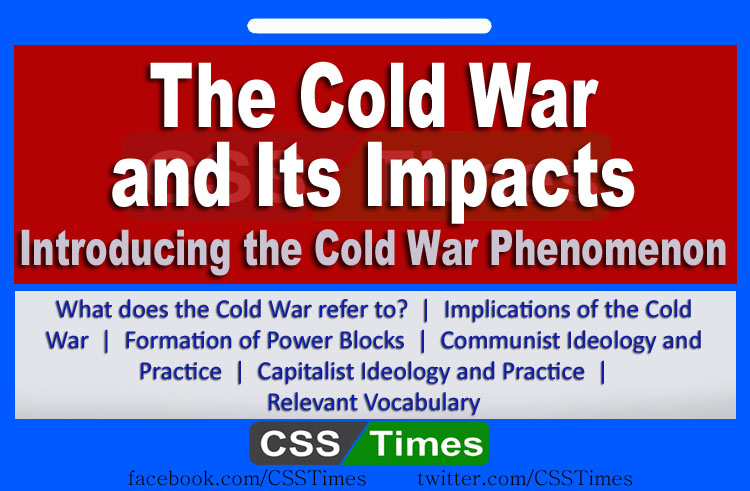What does the Cold War refer to?
The Cold War refers to the phenomenon that overshadowed world politics from the end of WWII until the fall of the former Soviet Union. It is one of the most significant events from the perspective of students of international relations.
Implications of the Cold War
The term Cold War signifies the state of affairs in which bitter relations, hostility and confrontation between the two post-WWII superpowers (US and USSR). The Cold War did not result in outbreak of war between the superpowers.
The Cold War did result in an arms race, diplomatic confrontation, proxy warfare, ideological competition which engulfed the entire world order. The Cold War resulted in formation of eastern and western power blocks and corresponding alliances and institutions under the Communist and Capitalist power blocks.
The United States accused the Soviet Union of seeking to expand their version of communism throughout the world. The Soviets, meanwhile, charged the United States with practicing imperialism and attempting to stop revolutionary activity in other countries.
Cold War tensions increased the likelihood of a third world war, which could have led to devastating consequences due to the possibility of nuclear conflict. The Korean War, the Vietnam War and the Soviet invasion of Afghanistan were some of the violent conflicts indirectly fueled by the Cold War.
Another manifestation was in the propaganda wars between the United States and the USSR. Indeed, it was far from certain that a global nuclear war wouldn’t result from smaller regional wars, which heightened the level of concern for each conflict. This tension shaped the lives of people around the world almost as much as the actual fighting did.
One major hotspot of conflict was Germany, particularly the city of Berlin. Arguably, the most vivid symbol of the Cold War was the Berlin Wall. The Wall isolated West Berlin (the portion of the city controlled by West Germany and the Allies) from East Berlin and the territory of East Germany, which completely surrounded it and was supported by the Soviets.
Formation of Power Blocks
The eastern (communist) power block led by the Soviets and the western (capitalists) power block by the US also formed alliances. The communist nations were held together by the Warsaw Pact and the capitalist power block formed NATO.
Communist Ideology and Practice
The common ownership of means of production and distribution provided the political and economic basis for the spread of communism, based on Marx‟s philosophy of empowering the proletariat.
Communism in practice resulted in dominance of a single political party and centralized decision making. The bureaucracy became the new bourgeoisie under communism in practice.
Capitalist Ideology and Practice
Capitalism is based on the notion of individual liberty and the right to own private property. At the political level, capitalism emphasized the need for democratic government, multiparty politics, the independence of the judiciary, and freedom of press. In practice capitalism has caused problems for minorities, growing inequalities and arguments concerning the role of the state in managing the economy.
Relevant Vocabulary
Centralized: controls resting with the central government instead of with regional authorities
Proletariat: the working class
Bourgeoisie: the elite
Empowering: the process of enabling a given segment of people the capacity to yield more political and economic power
Superpower: very powerful state, like the US in the current world politics circumstances
Before your leave check other our Other collection of CSS Notes
- CSS 2022 – MCQ Based Preliminary Test (MPT) Practice Paper with Answer Key (Download PDF)
- Islamic Studies MCQs (Download in PDF)
- The Ideal of Islamic Civilization and its Characteristics (CSS Islamic Studies Notes)
- Computer Fundamentals MCQs (Complete portion for FPSC & other Tests)
- SAARC Notes Handwritten (Download in PDF)
- Pakistan’s National Cyber Security Policy 2021 (PDF)
- Current Affairs Cloud for CSS /PMS Exams (June 19-20, 2021)
- Current Affairs Cloud for CSS /PMS Exams (June 17-18, 2021)
- Current Affairs Cloud for CSS /PMS Exams (June 16, 2021)
- Current Affairs Cloud for CSS /PMS Exams (June 15, 2021)
